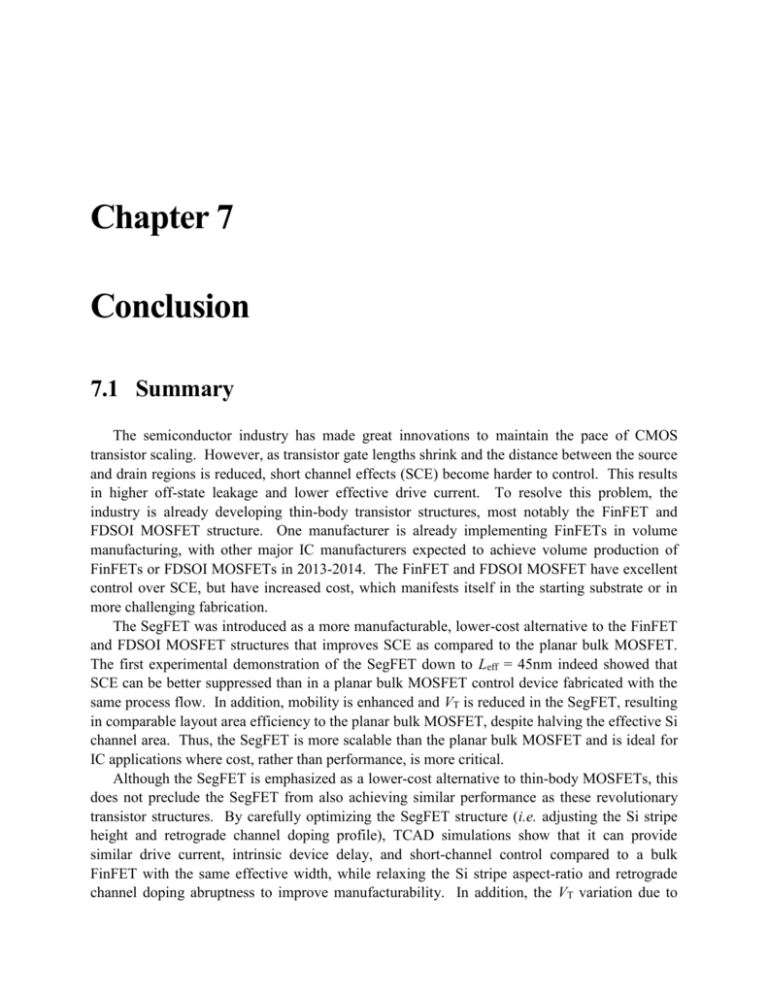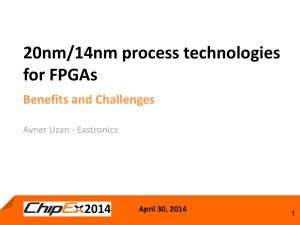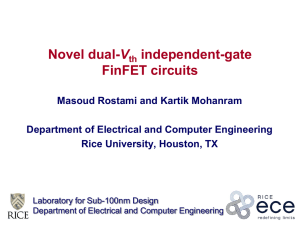Chapter 7
advertisement

Chapter 7 Conclusion 7.1 Summary The semiconductor industry has made great innovations to maintain the pace of CMOS transistor scaling. However, as transistor gate lengths shrink and the distance between the source and drain regions is reduced, short channel effects (SCE) become harder to control. This results in higher off-state leakage and lower effective drive current. To resolve this problem, the industry is already developing thin-body transistor structures, most notably the FinFET and FDSOI MOSFET structure. One manufacturer is already implementing FinFETs in volume manufacturing, with other major IC manufacturers expected to achieve volume production of FinFETs or FDSOI MOSFETs in 2013-2014. The FinFET and FDSOI MOSFET have excellent control over SCE, but have increased cost, which manifests itself in the starting substrate or in more challenging fabrication. The SegFET was introduced as a more manufacturable, lower-cost alternative to the FinFET and FDSOI MOSFET structures that improves SCE as compared to the planar bulk MOSFET. The first experimental demonstration of the SegFET down to Leff = 45nm indeed showed that SCE can be better suppressed than in a planar bulk MOSFET control device fabricated with the same process flow. In addition, mobility is enhanced and VT is reduced in the SegFET, resulting in comparable layout area efficiency to the planar bulk MOSFET, despite halving the effective Si channel area. Thus, the SegFET is more scalable than the planar bulk MOSFET and is ideal for IC applications where cost, rather than performance, is more critical. Although the SegFET is emphasized as a lower-cost alternative to thin-body MOSFETs, this does not preclude the SegFET from also achieving similar performance as these revolutionary transistor structures. By carefully optimizing the SegFET structure (i.e. adjusting the Si stripe height and retrograde channel doping profile), TCAD simulations show that it can provide similar drive current, intrinsic device delay, and short-channel control compared to a bulk FinFET with the same effective width, while relaxing the Si stripe aspect-ratio and retrograde channel doping abruptness to improve manufacturability. In addition, the VT variation due to RDF and gate LER is comparable between the SegFET and FinFET. Although the FinFET can achieve higher layout efficiency by making the height of the fin taller, this comes with increased process complexity. Since the 90nm technology node, MOSFETs have relied on strain engineering to enhance mobility. Today, most high-performance MOSFETs rely on drive current enhancement from strain techniques such as CESL-induced strain, strain memorization technique, and embedded source/drain stressors. As transistors continue to scale and as these strain techniques reach their physical limit, new channel materials with higher intrinsic mobility may be needed. The materials that can be integrated most straightforwardly in modern CMOS processing are Ge and Si1-xGex alloys. TCAD simulations were used to explore the design space of Si1-xGex/Si heterostructure channel pMOSFETs and it was shown that higher Ge concentration channels provide more drive current. However, at high Ge concentrations, performance is more sensitive to Si1-xGex channel thickness, possibly resulting in unacceptable process-induced variations. Thus, the optimal Si1-xGex heterostructure channel should be thin (< 2nm) and have a moderate Ge concentration (~ 20%-40%). Using the information gained from TCAD, thin (2-5 nm) Si0.5Ge0.5/Si heterostructure channels were implemented in experimental SegFET and planar (i.e. un-corrugated) pMOSFETs. The results showed that Si1-xGex channels on the SegFET structure exhibit better mobility and suppression of SCE, resulting in 30% improvement in ION per unit layout width for IOFF = 10nA/um compared to planar Si1-xGex channel control devices. The SegFET structure also drastically reduces the layout-width dependencies of VT and ID,LIN (that arise from Si1-xGex channel strain relaxation) compared to the planar MOSFET structure. This enables the use of thicker Si1-xGex channels (5nm-thick Si1-xGex channel SegFETs show 10% improvement in ION compared to 2nm-thick channel SegFETs) as well as higher Ge concentration to further boost mobility and performance. Finally, using TCAD and Monte Carlo simulations, pure Ge p-channel FinFETs were compared to strained Si FinFETs for device geometries near the end of the roadmap (LG = 8nm). Although the low hole transport mass of Ge (which is reduced further with application of strain) can achieve higher on-state drive current, it also results in more direct source-to-drain tunneling, leading to more off-state leakage and degraded subthreshold swing. Thus, for the same IOFF specification and VDD, strained Ge FinFETs have lower drive current than strained Si FinFETs for LG < 14 nm (due to smaller gate overdrive). Looking at effective current, Ge FinFETs fare even worse compared to its Si counterpart because of the higher dielectric constant and worse SCE. However, if Si cannot be strained to the level assumed in this study (1.5 GPa) or gate lengths cannot be scaled so aggressively, then Ge may be a promising alternative to Si for providing better transistor performance. 7.2 Suggestions for Future Work The work described in the preceding chapters has been exploratory in nature and implementing these ideas in industry will require more in-depth investigation. The SegFET devices presented in Chapters 2 and 5 demonstrated benefits over planar bulk MOSFETs, but to validate the suitability of replacing planar bulk with SegFETs in advanced technology nodes, these benefits must be confirmed with the use of more state-of-the-art technology such as highk/metal gate and strain techniques. Analog performance of SegFETs is another area of exploration, since it is likely easier to integrate SegFETs in a system-on-chip IC than FinFETs. Further experimental work is also needed to validate TCAD simulations and demonstrate the true scalability and performance of the SegFET structure for LG < 30 nm against its planar bulk and FinFET counterparts. To help guide this future SegFET work, TCAD was used to create a roadmap (modeled on the 2011 ITRS roadmap) for the SegFET structure described in Chapter 3. Whereas planar bulk MOSFETs and FinFETs rely on channel doping profile engineering and Si stripe width, respectively, to suppress SCE, SegFETs use both, and this difference is reflected in the roadmap below for high performance logic (HP), low-operating power (LOP), and lowstandby power (LSTP) technology requirements. Examining this roadmap, it is assumed that the SegFET stripe width is easy to manufacture since the Si stripe width is greater than or equal to LG, whereas manufacturable solutions for subLG FinFET widths are not known beyond 2020. The junction depth (or, equivalently, the depth of the retrograde channel doping) may pose difficulties for SegFETs beyond 2023. Novel epitaxy techniques need to be developed and optimized to achieve ultra-steep retrograde profiles and/or ultra-shallow junctions. Note, however, that it is generally easier to control the deposition of thin films rather than the etching of narrow lithographically-defined features. Roadmap for Planar MOSFET, SegFET, and FinFET (Adapted from 2011 ITRS Roadmap) Manufacturable solutions exist Manufacturable solutions are known Manufacturable solutions are NOT known High Performance (HP) Logic Technology Requirements Year Physical LG (nm) VDD (V) 2014 2015 2016 2017 2018 2019 2020 2021 2022 2023 2024 2025 2026 18 17 15.3 14 12.8 11.7 10.6 9.7 8.9 8.1 7.4 6.6 5.9 0.82 0.8 0.77 0.75 0.73 0.71 0.68 0.66 0.64 0.62 0.61 0.59 0.57 Equivalent Oxide Thickness (nm) Planar 0.73 0.67 0.61 0.55 SegFET 0.86 0.8 0.76 0.72 0.68 0.65 0.62 0.59 0.56 0.53 0.5 0.47 0.45 0.8 0.76 0.72 0.68 0.65 0.62 0.59 0.56 0.53 0.5 0.47 0.45 17 15.3 14 12.8 11.7 10.6 9.7 8.9 8.1 7.4 6.6 5.9 11.3 10.3 9.4 8.5 7.7 7 6.3 5.7 5.2 4.7 4.2 3.7 9.3 8.8 8.2 7.76 7.1 6.5 5.9 5.3 4.7 FinFET Stripe width (nm) SegFET 18 FinFET Junction Depth (nm) Planar 7.2 6.4 5.7 5 SegFET 12.6 11.9 10.7 9.8 Low Operating Power (LOP) Technology Requirements 2014 2015 2016 2017 2018 Year Physical LG 19 18 16 14.5 13.1 (nm) 0.65 0.63 0.61 0.59 0.57 VDD (V) 2019 2020 2021 2022 2023 2024 2025 2026 11.9 10.8 9.8 8.9 8.1 7.3 6.5 5.8 0.55 0.53 0.51 0.49 0.48 0.46 0.44 0.43 Equivalent Oxide Thickness (nm) Planar 0.75 0.7 SegFET 0.95 0.9 0.86 0.82 0.78 0.74 0.7 0.66 0.63 0.6 0.58 0.54 0.5 0.9 0.86 0.82 0.78 0.74 0.7 0.66 0.63 0.6 0.58 0.54 0.5 18 16 14.5 13.1 11.9 10.8 9.8 8.9 8.1 7.3 6.5 5.8 11.8 10.7 9.7 8.7 7.8 7.1 6.4 5.7 5.2 4.6 4.1 3.6 11.2 10.5 9.8 9.2 8.6 7.8 7.1 6.5 5.8 5.2 4.6 Technology Requirements 2016 2017 2018 2019 2020 2021 2022 2023 2024 2025 2026 17.5 15.7 14.1 12.7 11.4 10.2 9.2 8.2 7.4 6.6 5.9 0.78 0.75 0.72 0.7 0.67 0.65 0.63 0.61 0.59 0.56 0.54 FinFET Stripe width (nm) SegFET 19 FinFET Junction Depth (nm) Planar 6.5 5.4 SegFET 13.3 12.6 Low Standby Power Power (LSTP) 2014 2015 Year Physical LG 22 20 (nm) 0.84 0.81 VDD (V) Equivalent Oxide Thickness (nm) Planar 0.9 0.8 SegFET 1.3 1.2 1.1 1.0 0.95 0.9 0.85 0.8 0.75 0.71 0.68 0.64 0.6 1.2 1.1 1.0 0.95 0.9 0.85 0.8 0.75 0.71 0.68 0.64 0.6 20 17.5 15.7 14.1 12.7 11.4 10.2 9.2 8.2 7.4 6.6 5.9 12.5 11.2 10.1 9 8.1 7.2 6.4 5.7 5 4.5 4 3.5 12.3 11.4 10.5 9.8 9.1 8.2 7.4 6.6 5.9 5.3 4.7 FinFET Stripe width (nm) SegFET 22 FinFET Junction Depth (nm) Planar SegFET 6 5 15.4 14 Other interesting projects involving corrugated substrates and SegFETs include integration of other high-mobility materials such as pure Ge and GaAs using the aspect-ratio trapping method (ref. Chapter 2), with the aim of integrating optoelectronic devices (photodiode/receiver and light source/transmitter with Ge and GaAs, respectively) directly on the same chip as Si CMOS logic. In addition, since narrow Si stripes bordered by SiO2 acts as a waveguide material for the infrared wavelengths used in fiber optic telecommunication, integrated photonic chips may be more feasible using corrugated substrates. In regard to Si-xGex channels, experiments need to be performed to validate TCAD simulations of the Si1-xGex/Si heterostructure-channel pMOSFETs discussed in Chapter 4. To accomplish this, a high-k material with no Si capping layer should be used for the gate oxide to reduce the EOT. In addition, to maintain the integrity of the Si1-xGex channel, new techniques must be investigated to limit the Ge out-diffusion from the Si1-xGex channel (especially for Ge concentrations > 50%). These techniques can also be applied to Si1-xGex/Si channel SegFETs to ascertain the highest Ge concentration that can be practically incorporated within the Si1-xGex channel. For the TCAD simulations of the pure Ge double-gate pMOSFETs, it would be useful to conduct experiments to determine the true performance of Ge and Si FinFETs. Again, this will necessitate work on improving the gate oxide interface on Ge. Thick Ge films on Si (for tall stripe heights) also pose a process integration problem due to strain relaxation and defects at the Si/Ge interface, which must be minimized to achieve good device performance. 7.3 The Silicon Road(s) into the Unknown For the first time in 40 years, the semiconductor industry is at an enormous crossroads. Although the FinFET is the leading alternative transistor structure being developed by major manufacturing companies and provides better performance than the conventional planar bulk MOSFET, the extra development cost, more restrictive circuit design rules, and more difficult manufacturability may not make it cost-beneficial for the majority of IC applications such as those used in low-power and low-cost mobile devices. High-mobility channel materials are still an active area of research, yet it is still unclear when this technology will be implemented in mainstream products. As discussed in Chapter 1, the electronics industry is witnessing a movement toward the “internet of things” where electronic devices will pervade consumers’ lives, as is already seen in the proliferation of mobile communication devices. These inexpensive embedded ICs and sensors may not need the high performance that the FinFET and FDSOI MOSFET provide, nor the higher process development or substrate costs that are associated with these transistor structures. However, scaling transistor dimensions still benefit these lower-cost chips by reducing die size and cost-per-wafer. In the future, the semiconductor industry may diverge into two segments. One segment may focus on specialty applications using thin-body structures like the FinFET and high-mobility channel materials for server and datacenter applications where chip costs are of less concern. Another segment may pursue more manufacturable transistor designs like the SegFET for mobile devices and sensors, for which low cost (rather than performance) is a major determining factor in product success. Regardless of how the landscape of the semiconductor industry will look like in five or ten years, traditional transistor scaling is coming to an end as the planar bulk MOSFET pushes against the limits of process technology. It will take new innovations and breakthroughs in materials and process integration, as well as close collaboration with circuit, system, and software designers to create faster, cheaper, and more functional electronics. Although the electronics industry certainly faces a future full of unknowns, these unknowns also provide new opportunities for human ingenuity to continue pushing the capabilities of computing, technology, and humankind.








